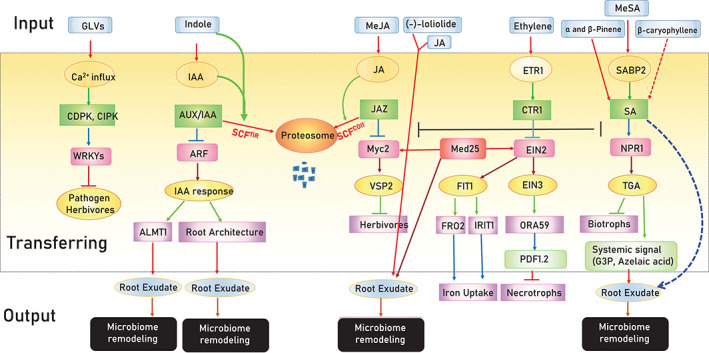FIGURE 2.

Signals from neighbouring plants modulate signalling pathways in receiver plants and induce microbiome remodelling. Signals can be sensed by receiver proteins (e.g. ETR1 sensor for ethylene) or converted to active signals [e.g. SABP2 for salicylic acid (SA)]. Signals are transmitted through well‐characterized downstream pathways that may cross‐talk with each other. These signalling pathways regulate defence mechanisms against different groups of attackers and induce plant microbiome remodelling by changing root exudation, thereby adapting the plant holobiome to respond to imminent threats. ALMT1, aluminium‐activated malate transporter; AUX1/LAX, auxin resistant 1/LIKE AUX1; CDPK, Ca2+‐dependent protein kinases; CIPK, calcineurin B like proteins (CBL)‐interacting protein kinase; CTR1, constitutive triple response 1; EIN2, ethylene insensitive 2; ETR1, ethylene response 1; FIT1, FE‐deficiency‐inducing transcription factor 1; FRO2, ferric reductase oxidase 2; G3P, glycerol‐3‐phosphate; IAA, indole‐3‐acetic acid; IRT1, iron‐regulated transporter 1; JAZ, Jasmonate Zim domain protein; Med25, mediator 25; MeJA, methyl jasmonate; MeSA, methyl salicylate; NPR, non‐expresser of PR genes; ORA59, octadecanoid‐responsive Arabidopsis 59; SABP2, SA‐binding proteins 2; SCFCOI1, Skp1‐Cul1‐F‐box protein coronatine insensitive 1 [Colour figure can be viewed at wileyonlinelibrary.com]
